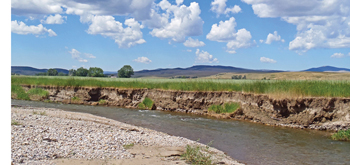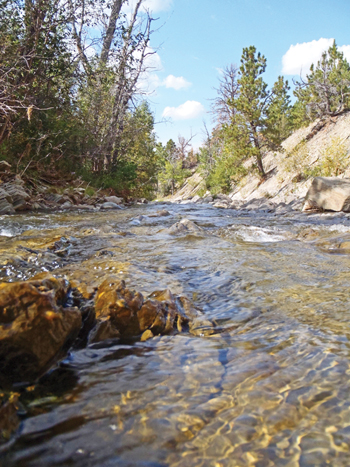Small Stream Splendor
Thursday May. 31st, 2012
 Ask anyone around the world about fly fishing in Montana and you are likely to hear about all of the big rivers and the close proximity to so many famous fishing destinations like the Madison, the Yellowstone, the Missouri, the Big Hole, the Bighorn, Yellowstone Park, and the list goes on. Montana’s Rivers are a destination for fly fishing travelers around the world for good reason, big brawling freestone rivers like the Yellowstone and Madison are famous for their insect hatches as well as the excellent dry fly fishing all summer long. The Missouri and Bighorn are world renowned for their prolific fish populations and consistent production of large fish. Yellowstone Park’s scenery is unmistakably beautiful, the wildlife abundant and the fishing for Cutthroats unparalleled by any other setting in the world. It should come as no surprise then that Montana’s fishing reputation is based largely on our number of large rivers and less on our other hidden gems, small creeks.
Ask anyone around the world about fly fishing in Montana and you are likely to hear about all of the big rivers and the close proximity to so many famous fishing destinations like the Madison, the Yellowstone, the Missouri, the Big Hole, the Bighorn, Yellowstone Park, and the list goes on. Montana’s Rivers are a destination for fly fishing travelers around the world for good reason, big brawling freestone rivers like the Yellowstone and Madison are famous for their insect hatches as well as the excellent dry fly fishing all summer long. The Missouri and Bighorn are world renowned for their prolific fish populations and consistent production of large fish. Yellowstone Park’s scenery is unmistakably beautiful, the wildlife abundant and the fishing for Cutthroats unparalleled by any other setting in the world. It should come as no surprise then that Montana’s fishing reputation is based largely on our number of large rivers and less on our other hidden gems, small creeks.
In a place so famous for its large rivers and destination locations, one might think that the rest of the fishing is worth overlooking, and that couldn’t be further from the truth. What really makes Montana special and sets it apart from anywhere else in the world is the number of productive small streams, feeder creeks and middle of nowhere fishing spots that make you feel like you’re the first one to have fished there. When people start throwing around names of locations that you can put a boat on or fish from a personal watercraft, chances are they are listed in a Fishing Guide to Montana somewhere and there’s been thousands of people there already. The sense of mysticism and wonder about fishing places that have State Fishing Access signs on them just doesn’t exist in Montana anymore. It’s not the 1950’s and the Wild West just doesn’t seem quite as “wild” as it used to with handheld GPS units, detailed topo maps, and programs like Google Earth that allow you to examine countryside like you never could even ten years ago. But for all the lack of wonder about the more famous locations, there’s plenty of streams that don’t appear in any guidebook, aren’t popular destination spots and you could occupy several lifetimes trying to fish them all. That’s what makes Montana special to me.
If you were to stick a pin in the middle of a map of Southwestern Montana and start gazing over all of the little blue lines that feed into bigger blue lines, that feed into the bold blue lines of major rivers, you’d begin to get a sense of just how much water there is to fish in the state. Nowhere in the lower 48 states is there more accessible, fishable trout water than in the state of Montana. Perhaps only New Zealand has more miles of trout streams, but Montana has more that you can access without a helicopter and a wad of money. The Stream Access Laws that we enjoy in the State of Montana allow fisherman to access all bodies of water from the public right of ways while staying below the high water mark, even when the lands surrounding them are privately owned. It is this little nugget of gold that makes Montana the most special place in the world to fish because you don’t have to be a millionaire to enjoy a sense of solitude on your own little stretch of water in the middle of nowhere. All you really need is some money for gas, a vehicle with some ground clearance, a road map and a sense of adventure and you can find plenty of places around Montana that count their annual visitors in the single digits and see more cows than people on any given day.
So the question then becomes, what creeks are worth fishing and how would you know if a body of water on a map has fish in it without reading about somebody else having been there before? Luckily for those of us with a sense of adventure, there’s an easy rule of thumb to follow in Montana – if there’s water in it, there’s fish in it. That may seem like an oversimplification, but nearly every little stream feeds into another little stream that feeds into a larger body of water eventually and every river in the Western half of Montana has trout in it. So all you have to do is look for rivers that hold trout, and then follow the little blue lines and you’ll find small streams that also hold trout. Now, how many trout and how big they are is a whole other story, and that really requires boots on the ground. It’s at this point in your small stream adventures that you should begin keeping logs of where you have fished, what drainages the creeks you are fishing feed into, and what kind of fishing you have found there. As you begin this exercise you won’t have much to go off of other than the relative productivity of the major rivers that the creeks feed into, but that’s enough to get you going. The natural progression of small stream fishing will lead you to determining which small streams in which drainages are more productive at what times of year, and then you can begin concentrating on areas that interest you.
Perhaps the best thing about small stream fishing is that it can be had right out of your back door and doesn’t have to involve maps, GPS locations, secrecy and miles on the tires. Sometimes the best small stream fishing can be done minutes from town on creeks that are simply overlooked by most fishermen in favor of the larger more famous rivers and streams around the area. The diversity of fishing opportunities coupled with generous public access makes living and fishing around Montana so special, and the catching of fish is simply a bonus. So the next time you feel like the rivers are a little crowded, or your favorite fishing hole has a dozen rigs parked at the access, think about heading to a road less traveled and wetting a line on a small stream. Trust me, you won’t regret it.
Kris Kumlien is the General Manager at Montana Troutfitters and can be found rambling on about anything to do with fishing at www.troutfitters.com
| Tweet |